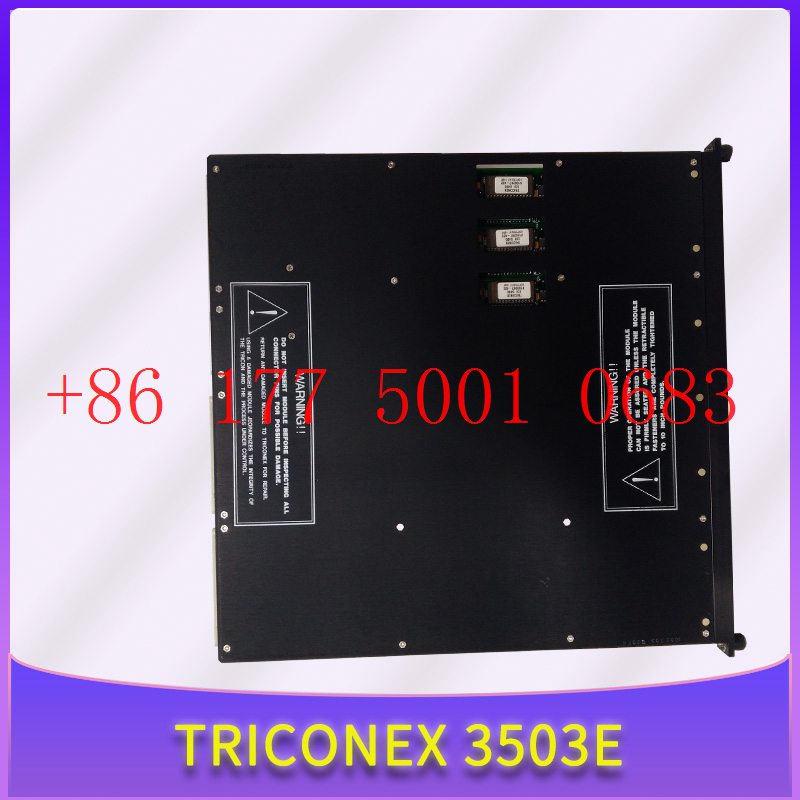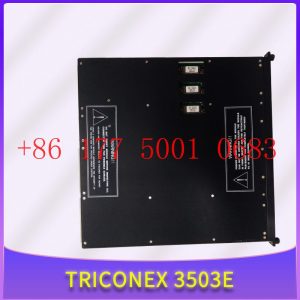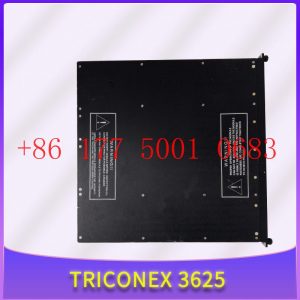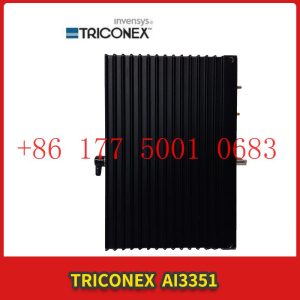Description
3626X Safety Instrumented System (SIS)
3626X Safety Instrumented System (SIS)
Module Clips Drive controller servo motor
Contact: Mr. Lai
Wechat:17750010683
Whats app:+86 17750010683
Skype:+86 17750010683
QQ: 3221366881
3221366881@qq.com
TRICONEX 3805E Invensys can accommodate the backplane of previous modules
TRICONEX 3805E Invensys can accommodate the backplane of previous modules
Fault tolerance in the TRICONEX 3805E is achieved through the the third mock examination redundancy (TMR) architecture. Tricon can provide error free and uninterrupted control in the event of hard faults or internal or external transient faults in components. Tricon adopts a completely triple architecture design, from the input module to the main processor and then to the output module. Each I/O module contains three independent branch circuits. Each pin on the input module reads process data and passes this information to their respective main processors. The three main processors communicate with each other using a proprietary high-speed bus system called TriBus. Every scan, the three main processors synchronize and communicate with their two neighbors through TriBus. Tricon votes on digital input data, compares output data, and sends copies of analog input data to each main processor. The main processor executes user written applications and sends the output generated by the application to the output module. In addition to voting on input data, TriBus also votes on output data. This is done on the output module as close to the field as possible to detect and compensate for any errors between the Tricon voting and the final output driven to the field.
The TRICONEX 3805E system typically consists of the following typical modules: [2]
Main processor modules (three).3626X Safety Instrumented System (SIS)
Communication module.
Input and output modules: can be analog and/or digital, can work independently, or can be hot backup (backup).
Power module (redundant).3626X Safety Instrumented System (SIS)
A backplane (chassis) that can accommodate previous modules.
System cabinet: One or more chassis can be compressed into one cabinet.
Organize cabinets to adapt and standardize interface connections between on-site instruments and Triconex system cabinets.
Human Machine Interface (HMI) for monitoring events.
Engineering Workstation (EWS) for programming. Monitoring, troubleshooting, and updating.
The remote IO module is designed according to the demanding industrial application environment requirements, embedded with a 32-bit high-performance microprocessor MCU, to meet various combinations of digital, analog, and thermal resistance IO modules. The communication protocol of the remote IO module adopts the standard Modbus TCP protocol, Modbus RTU over TCP protocol, and MQTT protocol. The remote IO module supports a wide working voltage of DC9-36V and has anti reverse protection function. It is equipped with a built-in watchdog and comprehensive lightning protection and anti-interference measures to ensure reliability.
The remote IO module supports 1 isolated 10/100M adaptive Ethernet interface with 15KV ESD protection, optocoupler isolated digital input, and supports dry wet contact input. The first channel can be used as pulse counting, supporting high-speed pulse and low-speed pulse modes. The default is high-speed pulse frequency with a maximum of 700KHz, and the optional low-speed pulse frequency with a maximum of 10KHz; DO output supports transistor Sink output, with the first channel available for high-speed pulse output, supporting pulse frequencies of 10Hz~300KHz; The remote IO module supports isolated 12 bit resolution analog input: 0-5V, 0-10V, 0-20mA, 4-20mA differential input; 1 channel RS485 communication interface, supporting standard Modbus RTU protocol for expansion; The thermal resistance RTD input supports two types: PT100 and PT1000;
What are the common types of IO extension modules? How much does an IO expansion module usually cost?
2. Analog Input Output Module: A module used to process and monitor analog signal input and output. Common analog input and output modules include modules based on resistors, transistors, and optocouplers.
3. Communication Interface Module: A module used to achieve communication between devices. Common communication interface modules include modules based on interfaces such as RS232, RS485, Ethernet, and CAN.
4. Special Function Module: A module used to implement specific functions. For example, the PWM (Pulse Width Modulation) module is used to control the speed and direction of the motor, and the counting module is used to achieve counting functions.
The price of IO expansion modules may vary depending on different brands, models, and functions.
Generally speaking, the price of more basic IO expansion modules ranges from tens to hundreds of yuan, while the price of IO expansion modules with more complex functions and stronger performance may be higher.
For example, the Io extension module ET1010 recently released by Zongheng Intelligent Control Company costs only 169 yuan per unit, and supports functions such as front-end and back-end cascading, sensorless expansion, and plug and play. It can be purchased in bulk or applied for a free trial address; The specific prices of these IO modules need to be queried and compared based on the specific modules you need.
MQTT IoT Remote IO Module Based on Ethernet Communication Technology
MQTT IoT Remote IO Module Based on Ethernet Communication Technology
Barium rhenium technology remote IO modules are widely used in IoT scenarios such as intelligent transportation, smart water conservancy, smart agriculture, smart campuses, smart communities, smart power distribution, and smart water conservancy.
With the development of IIOT industrial Internet of Things technology, more and more traditional assets need to be connected to the internet, achieving unified data collection and analysis, and breaking the phenomenon of traditional device information silos. The barium rhenium technology remote IO module M160T, which supports IoT protocols, has become an excellent choice for many enterprises to achieve device networking, remote control, and data collection based on the compatibility of existing devices and the accessibility of IoT platforms!
Ethernet communication technology is a mature communication technology because it has the characteristics of stability, reliability, mature technology, fast transmission speed, and fast construction wiring. Due to its wide application, Ethernet communication through the MQTT protocol is the main way for enterprise equipment to go to the cloud. Barium rhenium technology can quickly collect data and control such as air compressor room, property living pump room, street light control, liquid level collection, temperature and humidity collection through Ethernet remote IO module.3626X Safety Instrumented System (SIS)
So, why is the remote IO module of barium rhenium technology widely used in the field of industrial IoT? The specific reasons are as follows.
1. Actively connect to cloud platforms:
Based on the characteristics of Ethernet communication networks, the barium rhenium technology remote IO module does not require complex settings such as peanut shells to achieve the Internet of Things. The barium rhenium technology remote IO module needs to support both TCP client and TCP server functions.
2. Compatibility with existing systems:
It supports TCP Server and Modbus TCP protocol functions, and is compatible with device access of traditional upper level systems or HMI TCP clients.
3. Support multiple IoT platforms:
Supports standard MQTT, Modbus TCP, and Modbus RTU over TCP protocols. It can be connected to public cloud IoT platforms and user built MQTT private clouds through the MQTT protocol. It can also be connected to SCADA and DCS systems through Modbus TCP.
4. Rich IO interfaces and scalability:
There are many types of IO for industrial field data collection and replication. The Ethernet IO module of barium rhenium technology supports signal acquisition from various devices such as 4-20Ma, 0-20mA, 0-5V, 0-10V, RS485, DI, DO, PT100, PT1000, pulse input, pulse output, etc. At the same time, it expands the instrument data reading ability of RS485 devices.
5. Convenient installation method:
The volume of industrial on-site control boxes is often very limited, and the barium rhenium technology Ethernet IO module adopts a direct plug-in connection terminal and rail installation method. The compact volume greatly saves space in the control box!
6. Industrial grade design
The industrial environment is harsh, and the remote IO module using barium rhenium technology needs to adopt an industrial grade design, which can work continuously and stably in harsh environments.
Through the use of barium rhenium technology remote IO modules, there is no need to replace existing various enterprise assets, and the digital transition to the Internet of Things platform can be quickly achieved. Therefore, barium rhenium technology remote IO modules are widely used in industrial IoT, such as intelligent real estate, intelligent campus, intelligent factory, intelligent transportation, intelligent water conservancy, intelligent agriculture, intelligent campus, intelligent community, intelligent transportation, and many other industries.
What is the role of distributed IO modules and what are their main applications in
The distributed IO module transmits status signals from the measurement and control field to various measurement and control fields for control. It is mainly used in the industrial field and can also be used for detection of equipment such as air conditioners and motors.
In distributed systems, there are important business data closely related to system operation, as well as data related to nodes, application services, and data services, which are crucial for the normal operation of clusters.
IO on general PLCs is usually closely followed by CPU units, but in order to facilitate connection and maintenance, the concept of distributed IO has been proposed in the industrial field. That is to say, the IO unit can be arranged far away from the PLC CPU unit and communicate through the network communication protocol of the device layer.
The distributed IO module is developed for detecting and implementing remote control of various types of standard analog and switch signals (frequency, pulse, or switch state signals) in the field of measurement and control. The series of modules can digitize the test signal front-end and transmit it to the host through optical fiber; Or transmit the control instructions sent by the host to the controlled device to achieve remote control. Especially suitable for state detection and control of complex electromagnetic environments in power, industrial control, on-site switchgear, and large power equipment.
The role of distributed IO modules:
1. Support 4-way switch digital quantity
2. Supports 8 analog inputs
3. 4 relay outputs, 1 RS485 serial port data acquisition to Ethernet
4. 485 to Ethernet serial server
5. Supports Modbus to TCP/UDP protocol conversion
6. Supports virtual serial ports and interfaces with various configuration software
7. Support 0-5V, 0-10V, 0-30V range acquisition
8. Supports 0-20ma and 4-20ma range acquisition
Definition of IO Link Protocol and Its Interface
IO Link is a peer-to-peer, serial digital communication protocol designed for periodic data exchange between sensors/actuators and controllers (PLCs). The IO Link protocol was first proposed by Siemens and has now become an international standard IEC 61131-9. With the advancement of Industry 4.0, the use of IO Link is becoming increasingly widespread. Today”s article will introduce the definition of the IO Link protocol and its interfaces.
Factory automation can be divided into execution layer, on-site layer, on-site control layer, workshop control layer, and management layer according to functional division. As shown in the following figure:
The execution layer includes various execution mechanisms (valves, pumps, motors, etc.) and sensors, which are the muscles and peripheral nerves of factory automation. They receive commands from the upper layer and complete specified actions.
The on-3626X Safety Instrumented System (SIS) site layer includes various distributed IO3626X Safety Instrumented System (SIS) systems, which are the central nervous system of factory automation. It conveys control instructions from the upper layer to the execution layer; And feedback the signals from the execution layer to the control layer, serving as the information center;
The on-site control layer includes various PLC systems, which are the brains of factory automation. It issues corresponding instructions and commands the execution layer to complete corresponding actions based on internal program requirements and signal feedback from the execution layer;
The workshop control layer (MES) and management layer communicate with various PLC systems at the management level to complete management tasks at the workshop and factory levels.
The IO Link protocol to be introduced in this article is a protocol that transfers data between the execution layer and the field layer. An IO Link system consists of the following components:
1) IO Link Master;
2) IO Link Device;
3) Non shielded 3-5 core standard cable;
4) Tools for configuring IO Link parameters;
The IO Link Master transfers data between the IO Link device and the PLC. It is usually a distributed IO module with IO Link connection channels on the module. The IO Link Device is connected to the channel of the IO Link Master through a cable, and the IO Link Master exchanges data with the PLC through a bus. As shown in the following figure:
Every IO Link device needs to be connected to a channel of the IO Link supervisor, so IO Link is a peer-to-peer communication protocol, not a bus protocol.
IO Link devices are divided into two types: sensors and actuators: sensors are usually the four pin interface of M12, and actuators are usually the five pin interface of M12.
According to IEC 60974-5-2, the definition of IO Link Device pins follows the following regulations:
1) Pin 1 (PIN1): 24V power supply positive pole;
2) Pin 3 (PIN3): 0V
3) Pin 4 (PIN4): IO Link communication or standard IO output;
The pin definition of the IO Link device is shown in the following figure:
Which types of equipment should PLC module manufacturers develop first?
We know that PLC, also known as programmable logic controller, collects variable data through various IOs to achieve the purpose of automated control. Therefore, developing PLC is largely about developing IO. However, with so many types of IO, which PLC module manufacturers should develop first? Let me share my opinion:
1. Digital input IO, including PNP and NPN digital input IO, counter input IO, etc.
2. Digital output IO, including PNP and NPN digital output IO, PWM pulse output IO, relay output IO, and so on.
3. Analog input IO, including current acquisition input IO, voltage acquisition input IO, temperature acquisition input IO, and so on. The current input IO can collect currents ranging from 0 to 20 milliamperes, while the voltage input IO can collect voltages ranging from negative 10V to positive 10V. Temperature acquisition IO includes thermocouples and thermal resistors.
4. The style of analog output IO is similar to that of analog input IO, but does not include temperature analog, mainly voltage and current type.
Is it better to have a higher number of IO module bit widths?
IO is an important component of PLC, and the collection of PLC information and the output of instructions must be applied to various input and output IO. I don”t know if you have read some IO user manuals. One of their instructions is the device”s bit width, such as 12 bits and 16 bits. So, is it better to have a higher number of bit widths for the IO module? Let”s talk about this matter.
Bit width is the number of bits of data that can be transmitted within a clock cycle, and the larger the number of bits, the greater the amount of data that can be transmitted instantly. From this perspective, the larger the bit width of the IO module, the better. This is not a problem. However, the amount of data transmission, also known as data bandwidth, depends not only on the bit width, but also on the frequency of data transmission. The multiplication of the two is the final total amount of data transmitted. That is to say, even if the light position is wide, but the frequency is too high, it still cannot work. At the same time, the larger the bit width, the higher the hardware cost, and the greater the heat generation and power consumption of the device.
How to Apply Ethernet IO Module to Weighbridge Data Collection3626X Safety Instrumented System (SIS)
Weighbridge, a large scale set on the ground, usually used to weigh the tonnage of cargo carried by a truck. It is the main weighing equipment used for measuring bulk goods in factories, mines, merchants, etc. The MXXXX series of Ethernet IO modules with barium rhenium technology have rich IO ports that can be used to assist in data collection and transmission of the weighbridge, quickly achieving comprehensive management of data and control.
Before the vehicle enters the weighbridge, there will be an infrared sensor scanning about a few hundred meters. The infrared sensor will output a switch signal to the Ethernet IO module, indicating that a vehicle needs to enter. Before the vehicle officially enters the weighbridge for weighing, there will be an infrared barrier sensor scanning, and the barrier will also output a switch signal to the Ethernet IO module. When the vehicle is completely parked in front of the weighbridge (including whether the position is correct), the central control room will decide whether to start weighing based on the information received by the IO module from the radar sensor. Finally, the vehicle is weighed and drives away from the weighbridge. The scanning signal from the infrared barrier sensor at the exit is transmitted to the IO module, and the central control room controls the IO port of the IO module to open (close) the barrier. The green light will light up, and the vehicle will fully exit and leave the weighing weighbridge. The entire weighing process requires only one Ethernet IO module to collect information and control actions.3626X Safety Instrumented System (SIS)
The MxxxT industrial remote Ethernet I/O data acquisition module adopts an industrial grade circuit design. The digital input adopts optocoupler isolation, providing 12 pulse counting inputs, supporting dry and wet contact input types. The analog input adopts operational amplifier isolation, supporting 12 bit high-precision data acquisition, compatible with 0~5V, 0~10V, 0~20mA, and 4~20mA input types. The DO output is a transistor Sink output, providing one channel of high-speed pulse output, The thermal resistance RTD input supports two types: PT100 and PT1000, and the analog AO output supports 0-10VDC output.
Pocket Io ™ The development platform has opened up numerous new avenues for experiencing the full power of Industry 4.0.
Compact design: compact structure, ultra small size, and overall dimensions (10 cubic inches: 3.5 “x 3.5” x 0.8 “).
Reliable and safe technology: Composed of advanced industrial products, all products have a rated working environment temperature of -40 ° C to+125 ° C, fully utilizing Maxim”s reliable, safe, and fast demagnetization technology.
Efficient: Ensure low power consumption and improve efficiency – no need for cooling fans.
Integrate numerous powerful interfaces: provide a complete set of 30 IOs for controlling the entire manufacturing node or a certain device, including: 4 analog inputs, 1 analog output, 8 digital inputs, 8 digital outputs, 2 RS-485 (compatible with Profibus fieldbus), 3 encoder/electrical control ports, and 4 IO Link hosts.
Long battery life: Firstly, the compact and portable PLC platform can work for up to 2 hours using “AA/AAA” type batteries, and 8 hours using LiFePO4 rechargeable batteries.
Programmable: It can be programmed through Arduino Sketch or using Intel”s Edison Eclipse IDE tool, supporting Windows, Linux, or Mac OS operating systems.
Easy to use: Sketches can be converted into apps and then downloaded to iPads ® Or iPhone ® (Converted to an HMI panel for controlling Pocket IO).
What are the advantages of Ethernet remote IO modules that can be cascaded?
Advantages and specific application scenarios of Ethernet remote IO modules that can be cascaded
For scenarios where data collection control points are linearly distributed, such as streetlights, bridges, streetlights, digital factories, parking lot parking monitoring, smart parking lots, smart parking racks, and building automation control systems in smart parks, using cascading dual Ethernet remote IO modules saves more costs than using single Ethernet remote IO modules.
The Ethernet remote IO module that can be cascaded is a new type of Ethernet remote IO module that supports MAC layer data exchange and can achieve hand in hand connection. This not only saves switch interfaces, but also reduces a large amount of Ethernet cable costs, wiring space, and wiring costs.
Its advantages are as follows:
1. No need for a large number of Ethernet switches or occupying Ethernet switch ports;
2. It can save a lot of Ethernet cables, cable space, and labor costs for installing cables;
3. The overall cost has significantly decreased;
4. Supports both Modbus RTU protocol, Modbus TCP protocol, and the Internet of Things protocol MQTT protocol;
5. Support TCP Server and TCP Client services;
6. Can be connected to SCADA systems, PLC systems, or cloud platforms;
7. The series uses a MAC layer for data exchange, ensuring that network connectivity does not cause communication issues with subsequent devices due to device failures in the middle.
The comparison between cascaded Ethernet remote IO modules and traditional IO modules used in building automation systems is shown in the following figure:
1. Adopting a cascaded dual Ethernet remote IO module, data acquisition and control wiring for floors with a height of 70 meters only requires a 70 meter Ethernet cable;
2. Using a traditional single Ethernet remote IO module, the data acquisition and control system wiring for a 70 meter high floor requires a 280 meter Ethernet cable.
It can be seen that using cascaded dual Ethernet remote IO modules can save a lot of wiring costs compared to traditional single Ethernet remote IO modules.
1.Has been engaged in industrial control industry for a long time, with a large number of inventories.
2.Industry leading, price advantage, quality assurance
3.Diversified models and products, and all kinds of rare and discontinued products
4.15 days free replacement for quality problems
ABB — AC 800M controller, Bailey, PM866 controller, IGCT silicon controlled 5SHY 3BHB01 3BHE00 3HNA00 DSQC series
BENTLY — 3500 system/proximitor, front and rear card, sensor, probe, cable 3500/20 3500/61 3500/05-01-02-00-001 3500/40M 176449-01 3500/22M 138607-01
Emerson — modbus card, power panel, controller, power supply, base, power module, switch 1C31,5X00, CE400, A6500-UM, SE3008,1B300,1X00,
EPRO — PR6423 PR6424 PR6425 PR6426 PR9376 PR9268 Data acquisition module, probe, speed sensor, vibration sensor
FOXBORO — FCP270 FCP280 FCM10EF FBM207 P0914TD CP40B FBI10E FBM02 FBM202 FBM207B P0400HE Thermal resistance input/output module, power module, communication module, cable, controller, switch
GE —- IS200/215/220/230/420 DS200/215 IC693/695/697/698 VMICPCI VMIVME 369-HI-R-M-0-0-E 469 module, air switch, I/O module, display, CPU module, power module, converter, CPU board, Ethernet module, integrated protection device, power module, gas turbine card
HIMA — F3 AIO 8/4 01 F3231 F8627X Z7116 F8621A 984862160 F3236 F6217 F7553 DI module, processor module, AI card, pulse encoder
Honeywell — Secure digital output card, program module, analog input card, CPU module, FIM card
MOOG — D136-001-007 Servo valve, controller, module
NI — SCXI-1100 PCI – PXIE – PCIE – SBRIO – CFP-AO-210 USB-6525 Information Acquisition Card, PXI Module, Card
Westinghouse — RTD thermal resistance input module, AI/AO/DI/DO module, power module, control module, base module
Woodward — 9907-164 5466-258 8200-1300 9907-149 9907-838 EASYGEN-3500-5/P2 8440-2145 Regulator, module, controller, governor
YOKOGAWA – Servo module, control cabinet node unit
Main products:
PLC, DCS, CPU module, communication module, input/output module (AI/AO/DI/DO), power module, silicon controlled module, terminal module, PXI module, servo drive, servo motor, industrial display screen, industrial keyboard, controller, encoder, regulator, sensor, I/O board, counting board, optical fiber interface board, acquisition card, gas turbine card, FIM card and other automatic spare parts







